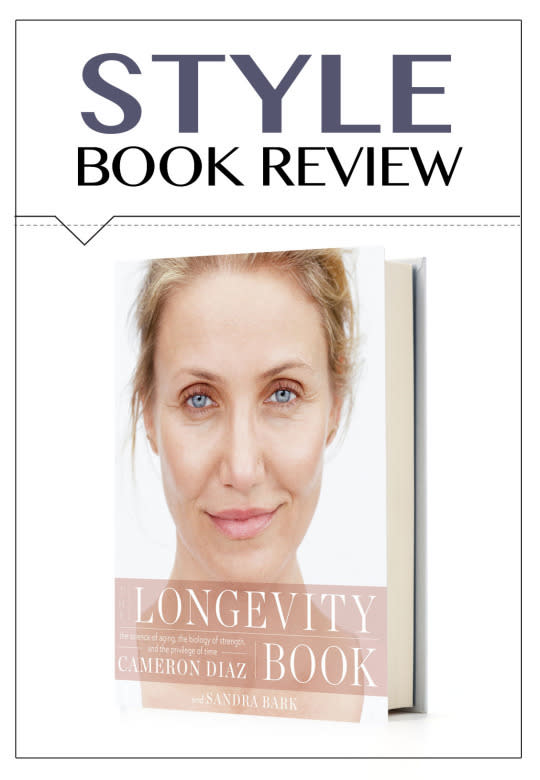Cameron Diaz’s New Book Is a No-BS Look at Aging

The Longevity Book, written by Cameron Diaz and Sandra Bark. (Photo courtesy of HarperCollins)
I was more than prepared to dislike Cameron Diaz’s new Longevity Book. I admittedly didn’t read her first offering, The Body Book, which spent 26 weeks on the New York Times bestseller list. The Body Book’s cover photo of Diaz’s long, splayed bronzed limbs provided more than enough incentive for me to skip it (did I really want to torture myself with page after page of health and fitness recommendations I’d never take to attain a physique I’d never have? Not really.)
That said, after reading The Longevity Book, Diaz’s aging-focused followup, I realized my prejudgment of The Body Book might have been a bit harsh. That’s not to say I wasn’t skeptical about Longevity — don’t normal, non-Hollywood women who don’t look like Diaz experience enough pressure to look and feel forever pliable despite their advancing years and deepening frown lines? Thankfully, The Longevity Book was a bit of a surprise — in a good way.
Targeted at women 35 and up, the book is a refreshingly broad and ambitious look at aging, health, and the discrepancies between the lifespans (and lifestyles) of women and men. Though they fleetingly mention the aesthetic affronts that begin to pile on as women hit their peak years — the less than bouncy boobs, the sudden sprout of new hairs in unexpected places — Diaz and co-author Sandra Bark focus almost entirely on the internal shifts that come with growing older (think sleep issues, heart disease, depression, muscle loss) and actions women can take to manage them.
Diaz’s message is clear — as she writes in the introduction: “This is not an antiaging book. I’m not going to tell you how to trick time or reverse the aging process in thirty days.” In fact, she doesn’t attempt to tell readers how to reverse anything at all, really. Instead she and Bark focus on concisely explaining the science behind everything from perimenopause to thyroid disease to the endocrine system. The book even bears a feminist slant, touching on the medical establishment’s offensive history of labeling women with questions about anxiety, mood issues, or sexual as “hysterical.”
Aging is “not a crisis; it’s a rite of passage,” Diaz notes. And though, throughout sections with titles like “A Brief History of Women’s Medicine” and “Steep Grades, Sharp Curves,” Longevity attempts to stay positive but unflinching in its demystification of women’s evolving organs, at times it made me ache to return to the innocuously robust days of prepubescence. In one passage, the authors depressingly explain that, physiologically, things start going south as early as the teen years: “… Right when your boobs were at their perkiest, when you weren’t thinking about getting older except maybe to turn 21 so you could get into bars and clubs legally, the aging process was starting to take hold deep within your body.”
In a section outlining the variety of reasons women tend to live longer than men, Diaz notes, “And women are less likely to take risks,” which is apparently equated with greater health and longevity but which I equate with a sad, boring existence.
Of course, there are affirming elements too, like the promising if vague tidbit that many folks find “… aging can bring positive feelings like increased enjoyment and satisfaction,” and a reassuring statistic that the happiest people around the world fall between the ages of 82 and 85. Plus, Diaz is at times unintentionally hilarious, like when she recounts telling her 8-year-old niece, who was gushing about her baby sister’s “smooth and velvety” skin: “Your skin used to be that soft … and one day you’ll have skin like mine. We’re all moving forward. … We’re like fruit on a tree. A little seed comes out, then a flower, then a fruit, and when it gets too ripe, it drops off and falls on the ground. It gets eaten by animals. It becomes part of the earth.”
Because I’m no scientist and I bore easily, I found myself skimming through the more clinical parts, like the authors’ explanation of healthy versus senescent cells (replete with cute illustrations). Diaz’s dedication to exploring the mechanics of aging on a cellular level is noble though, and I applaud her for taking her analysis of a fraught subject so far beyond skin-deep. Maybe I’ll pick up The Body Book sometime, after all.
Follow us on Facebook, Instagram, and Pinterest for nonstop inspiration delivered fresh to your feed, every day.
